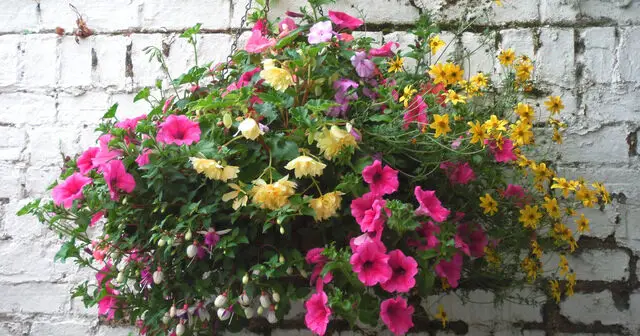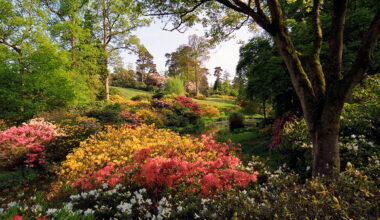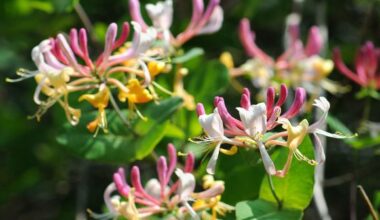There are dwarf and compact nasturtiums, as wide as they are tall (10 to 15 inches), but also climbing nasturtiums (nasturtiums) whose stems crawl or climb on their support up to 10 feets high.
The nasturtiums emit long, glass-brittle stems that are voluble in climbers. Their large alternate and rounded leaves (in botanical language, we say “peeled” term meaning shield-shaped) offer a bright green to bluish green color sometimes with a creamy variegation in some varieties.
It is the perfect plant to grow in a hanging basket, we explain how to proceed in this article!
Contents
Nasturtiums in hanging basket
Nasturtiums can be sown in pots, raised beds or pots on a balcony. It can also be installed in a hanging basket. Proceed in the same way as for planting in the ground.
How to plant nasturtiums in hanging baskets?
All annual nasturtiums and some less hardy perennial species are suitable for pot or suspension culture. Nasturtiums can be grown as easily in hanging baskets as in the ground. Dwarf or half-dwarf forms are ideal for this purpose. Cold perennials can be stored at the first frost or kept in a warm veranda all year round.
- Choose a jar with a hole in the bottom to allow water to drain out.
- Allow 6 inches in diameter and depth for a dwarf nasturtium and at least double that for a climbing.
- Also start by rehydrating the root ball of your nasturtiums.
- Install a bed of clay beads to facilitate drainage, and cover it with a drainage blanket if necessary.
- Use a draining soil such as Mediterranean plants.
- 6. Place the plant, plug up and gently press down.
- Water copiously and re-soak the plant if necessary to prevent the roots from drying out.
- Install the whole in a hanging basket
How to drive your nasturtiums
Don’t forget to provide a place where your nasturtiums can climb. In general, the nasturtiums will simply crawl, so it will be useful to provide some wires or spikes to make it climb where you want it to.
But if you wish, you can simply let a plant crawl alone on the ground or on a pile of wood etc.. Another good place is close to plants that may fear aphid attacks, because as we will see, nasturtiums can help the regulation of aphids in the vegetable garden.
Maintenance of the nasturtiums
Watering
Water the nasturtiums regularly in a hanging basket to keep the substrate cool throughout the summer. No need to renew any mulching, their covering foliage quickly acts as a ground cover limiting water evaporation.
Good to know: a nasturtium that is overwatered will see its foliage turn yellow.
Fertilization
Water the nasturtiums in hanging baskets once a month with a special fertilizer for flowering plants. No more under penalty of rarefying the flowers for the benefit of the luxuriance of the foliage.
The cultivation needs of the nasturtiums
From February to March: 2 or 3 seeds are sown per pot. The soil is kept very moist until germination and over 50°F. Repot in a larger pot without disturbing the roots then put in place in May. When transplanting in the ground, unmould it like a pâté and integrate it into the bed.
How to multiply nasturtiums?
This tuberous nasturtium multiplies by sowing. The germination is erratic and is thus not always obvious to obtain, but the vegetative multiplication is long and difficult. It is better to sow the freshest possible seeds, and not to store them beyond 7-8 months.
They are sown in late summer/fall in a draining mixture, covered with 1 inch of sand and kept at about 39°F. They germinate in 1 month. The seedlings grow quite fast, and often show a different cycle than the mature plant; it is not uncommon for the young plant to remain in leaf all year round.
Attacks and diseases
Vigorous and rarely sick unless over watered when in a hanging basket, the nasturtium flower is however often parasitized by black aphids. This defect even makes it worthwhile to plant it in the vegetable garden, because it attracts aphids that leave the vegetables alone. If the ladybugs are slow to come, shower the parasitized shoots with water and black soap.
Summary
Decorative and uncomplicated climbing plant that also thrives in locations with little sunshine and in unfavourable soil. It is often used for fences and as a hanging basket or balcony plant.
Allows to improve the vegetation at the base of the facades by completing the climbers that tend to be bare at their base. Also interesting as an indoor plant.









